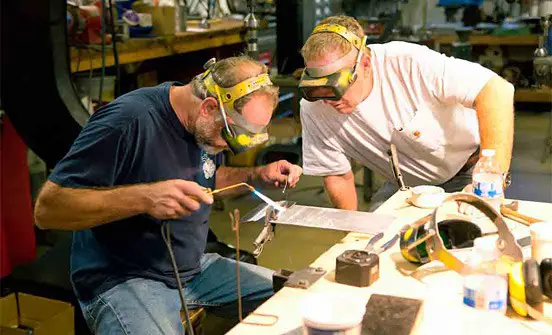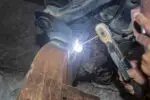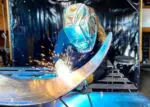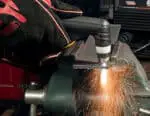There are many forms of welding – underwater welding, welding using machines that do not require gas, and welding with machines that require gas. Similarly, one form of welding is using a blowtorch to weld. A blowtorch requires gas to operate and weld. But, welding with a blowtorch is indeed possible.
You can weld with a blowtorch that runs on fuel gases, propane, oxygen, as well as hydrogen. Even a butane blowtorch can be used to weld metals.
The two preliminary requirements to weld metals and joints are heat and thermal energy. Since a blowtorch provides both (heat and thermal energy), it can be used for welding.
Unlike normal forms of welding, welding with a blowtorch requires skills. It’s a work of precision and skills so that the metal that’s being welded doesn’t break.
Most welders, especially those who are new to the business of welding, should take classes and courses to learn how to use a blowtorch.
One needs to control the flow of gases when using a blowtorch to weld. It’s very important to reach the desired temperature and then maintain it. If you’ve been thinking about switching to weld using a blowtorch, this guide will be a delightful read.
Expect to learn everything about using a blowtorch to weld: the technique, the procedure, the risks, the benefits, the challenges, and much more.
The Correct Technique To Use a Blowtorch: What Gases Can be Used?
Using a blowtorch to weld metals can be quite tricky. There’s a correct technique that you must follow step-by-step to carry out welding with a blowtorch safely.
Before we can take you through the technique with which you should use a blowtorch, we’d like to make a mention of the gases that can be used to weld using a blowtorch.
Here are the straight gases (and fuel gases) that you can use for blowtorch welding:
-
-
- A blend of fuel gas and oxygen
- Propane
- Hydrogen
- Butane
- Acetylene
-
That being said, it’s time to already take you through the right technique to use a blowtorch for welding.
Have a look!
#1 Adjusting the Mixture of Gases
Whether you’re using straight gas or fuel gases to weld using a blowtorch, you should first focus on carefully adjusting the amount of oxygen and fuel gas.
This particular step should be carried out as soon as you switch open the valve of the oxygen cylinder. Keep adjusting the flame until its color turns blue.
#2 Start Using the Blowtorch in a Circular Motion
As soon as the flame turns blue, make sure that the metal pieces to be welded together are held closely. Start using the blowtorch in a way that the flame covers the entire surface of the joint in a circular motion.
Look very closely! If you find that a pool of molten metal has already been formed, it’s time to push down the collected metal and weld it in a straight line using the blowtorch.
The presence of any gap or crevice should be filled with more metal with the help of a blowtorch in the same manner as described above – moving the blowtorch in a circular motion first and then welding the gathered metal in one straight line.
Bear in mind, it’s important to keep a welding rod handy and close by when using a blowtorch to weld. You’ll need the welding rod to fill the gap between the two metals. Any lag will make the joint brittle upon cooling.
The kinds of Metals that Different Blowtorches can Melt and Weld
Different gases are used to ignite a flame in a blowtorch. Naturally, it gives rise to a lot of questions about what gases can weld which metals. This particular section will answer all such questions.
1.) Can a Propane torch Melt Steel?
The answer is yes. Yes, a propane blowtorch can melt steel. However, here’s the catch: propane takes longer to reach the desired temperature of 1800° F, and steel, and most other metals, can melt at about 1800° F.
Time-consuming? Yes! Impossible? Absolutely not! Propane itself has a heat point of 1900° F. Naturally, it will melt steel. In fact, you can use a propane blowtorch to braze metals as well.
2.) Can You Solder With Butane Torch?
Butane is another gas that’s used to ignite a blowtorch. Since the heat point of a butane blowtorch can reach as high as 2500° F, it can be used for soldering metals such as copper and silver.
3.) Which metal can a blowtorch Melt?
Depending upon the gas you’re using, a blowtorch can melt metals like copper, bronze, stainless steel, silver, brass, and aluminum.
In fact, as already mentioned, since the melting point of most metals is 1800° F, a blowtorch is able to melt, braze, and solder most metals that you can possibly think of.
3 Dangers of Using a Blowtorch for Welding
A blowtorch can reach very high temperatures. The very fact that it uses combustible fuel gases like oxygen is the biggest danger of using a blowtorch. You have to be very careful when using one.
Other than using combustible gases, there are some other significant dangers of using a blowtorch to weld. Have a look!
1.) The flame emitted from a welding blowtorch is extremely bright. The lapse of tinted protective welding glasses can harm your vision and weaken it.
2.) If the pressure of the gas suddenly drops (or stops altogether), there’s a very high probability of a backfire. It’s not usually life-threatening, but the loud popping sound due to backfire can cause short-lived tinnitus.
3.) A flashback, on the contrary, is extremely dangerous. Although a backfire won’t hurt you, a flashback will. It occurs if there’s a clog. Since the fuel gases are extremely combustible, a flashback can also cause a fire.
3 Benefits of Using a Blowtorch for Welding
You have to be a pro at using a blowtorch to weld. When you’re trained to handle the pressure and adjust the gases so that there’s no danger of a flashback or backfire, the benefits of using a blowtorch torch to weld are significant. Have a look!
1.) A blowtorch is a handheld device. Hence, it offers ease of use. Besides, it can be used to melt a lot of metals. So, it finds applications and uses in many industries.
2.) You can use a blowtorch to pre-heat castings so that they can be welded and repaired easily.
3.) A blowtorch first creates a weld pool by melting the metals that have to be welded together. Molten metals mix very well, filling all the gaps very smoothly. The resulting joint is very strong.
Concluding Thoughts:
Welding with a blowtorch comes with its own sets of challenges. However, the joints that are welded using a blowtorch are very strong and neat. That’s one of the biggest reasons that blowtorch welding is so popular.
A welder has to take courses and, at times, certifications are mandatory for the purpose of declaring that the welder is indeed professionally trained to control the flow of gases so that there’s no danger of causing a fire.
Bear in mind, there are many perks of blowtorch welding, and different fuel gases that are used to ignite a flame can melt most metals. Hence, with the right amount of training, you can safely use a blowtorch to weld metals by melting them first.








